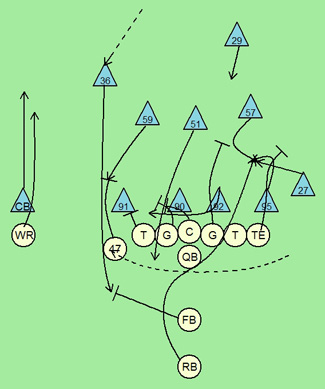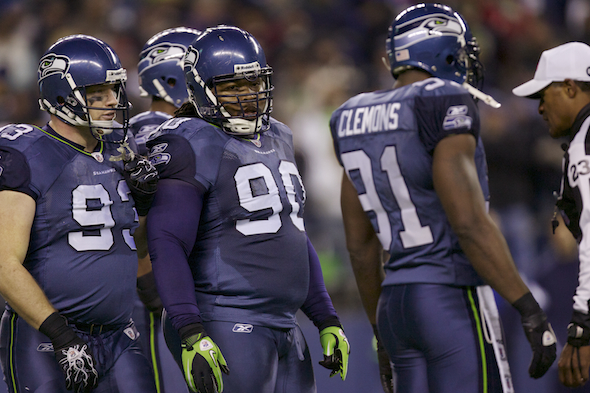The Seahawks run defense has been quite the little adventure this season. Starting out the year with Pete Carrolls over, under, and Leo front concepts, Seattle had one of the NFLs best run-stopping squads until Red Bryant suffered a season-ending injury in the Week 8 loss to the Oakland Raiders. The initial solution to the Bryant problem was to install former 49ers first-round pick Kentwan Balmer into that role, but Balmer proved less skilled at a static run-stopping spot than the more traditional four-man hybrid fronts he was a part of in the Bay Area.
Reserve lineman Junior Siavii proved to be a better fit until he, too, suffered an injury that ended his season. Left with Balmer as the five-tech option for the possible division-clinching game against the St. Louis Rams, Carroll, defensive coordinator Gus Bradley, and defensive line coach Dan Quinn most likely took a good look at Rams running back Steven Jackson and decided to deal with their line in different fashions than the sieve Balmers spot had become. Most specifically, rookie LeGarrette Blount ran all over Balmers spot in Seattle Week 16 loss to the Tampa Bay Buccaneers.
Adjustments would have to be made. In five games with Balmer as a reserve tackle or end, the Seahawks allowed 77.8 rushing yards per game. In three games with Balmer as the starting left defensive tackle, the Seahawks allowed 137.7 yards per game. And in eight games with Balmer at starting right defensive end, the Seahawks have given up 137.6 yards per game, but that included the 47 yards the team gave up against the Rams in their 16-6 win.
Against St. Louis and Jackson, the Seahawks used Balmer, and the concept of the five-tech end, in a few different ways. First, they would place Balmer at the five-tech in a more static and traditional five-man front, where Balmer played end as he would in a defense like Pittsburghs or Dallas’. And if they did have Balmer outside in a four-man front, there would generally be additional run support from a defensive back. Thus, the usual cutback running plays that had proven so successful for opponents in the past were stopped far more often against Jackson, who rushed for just 45 yards on 11 carries.
 Perhaps the play which best indicated the extra protection the Seahawks gave Balmer came with 5:33 left in the second quarter, and the Seahawks up, 7-3. The Rams had the ball on their own 16-yard line with second-and-4. They lined up in an I-formation, two-tight end set with Daniel Fells (47) in motion from left to right. At the snap, Jackson and fullback Mike Karney headed left clearly, the idea was to get the defense rolling to the weak side and cut back to Balmers position.
Perhaps the play which best indicated the extra protection the Seahawks gave Balmer came with 5:33 left in the second quarter, and the Seahawks up, 7-3. The Rams had the ball on their own 16-yard line with second-and-4. They lined up in an I-formation, two-tight end set with Daniel Fells (47) in motion from left to right. At the snap, Jackson and fullback Mike Karney headed left clearly, the idea was to get the defense rolling to the weak side and cut back to Balmers position.
It had worked before, but the Seahawks had a plan this time. Safety Lawyer Milloy (36) crashed down from his two-deep position, cutting off the weak-side edge as Karney blocked him out. The line headed left, except for right guard Adam Goldberg, who chipped tackle Brandon Mebane (92) and headed upfield to block linebacker David Hawthorne (57). Lofa Tatupu (51) bit on the initial run direction, and Aaron Curry got cut off by Fells, but as Balmer dropped back on his side, Hawthorne came down to help Balmer, and cornerback Jordan Babineaux (27), who was playing an inside run fit, assisted with the wrap-up.
For Mebane, the key in this game beyond the schemes was improved gap discipline. “The main thing was that everybody was doing their jobs,” he said. “Over, under, whatever we call — everybody had to do their job and play their gap. Once we came to an agreement to just do that, the results showed.”
However, Seattles coaching staff really did pull out all the stops in this game; we discussed yesterday just how much Jeremy Bates customized the offensive playbook for Charlie Whitehurst, and this defensive play was but one example of how the defense was helped by thinking outside the box.
In this game plan there are two things we did really well, Carroll said on Monday. There were two huge factors alongside with (Rams quarterback) Sam (Bradford), and that was Steven Jackson, and we were able to keep him to a point where he was not a big factor in the game, and then (receiver Danny) Amendola was the other factor and we did a great job on him. The guys really handled the game plan beautifully, to keep him (Amendola) to two catches for next to nothing yardage-wise and hold him down on his returns as well, was a big part of factoring in on this game. These guys on the defensive side really took to heart the plan, and figured it out, and made it work. You could see numbers of times when he (Bradford) just had nowhere to go with the football in terms of getting it to his favorite guys. So that was a big deal.
Bradley talked about the fact that, as Carroll intimated on Monday, the Rams were actually forced to audible out of several run plays because the fronts were so solid. “It was good, and our safety rotation, too — we were trying to disguise a little bit. They got us on a couple routes right away, but we didn’t think thery were going to stick with that. Obviously, our number-one goal in every game is to try and stop the run, and then we can get our (pass) rush going.”
The run defense was the defining element in the team’s final game of the regular season. If Jackson had been able to gash the Seahawks front seven as other backs recently did, Carroll might have been discussing it from his last press conference of the 2010 season.


2 Comments
Thanks! We’ve been doing X-and-O reviews every Tuesday and previews every Thursday or Friday. Check the Pressing the Point archive if you’d like to see more. http://seahawks.sportspressnw.com/category/pressing-the-point/
Doug – dito for me – I really appreciate the breakdowns. Thanks!